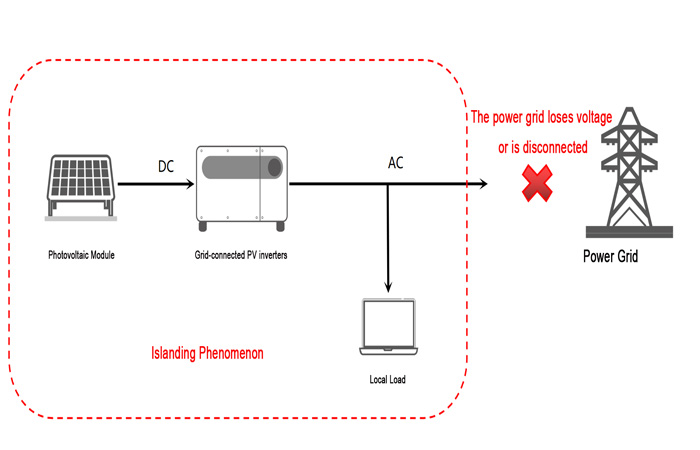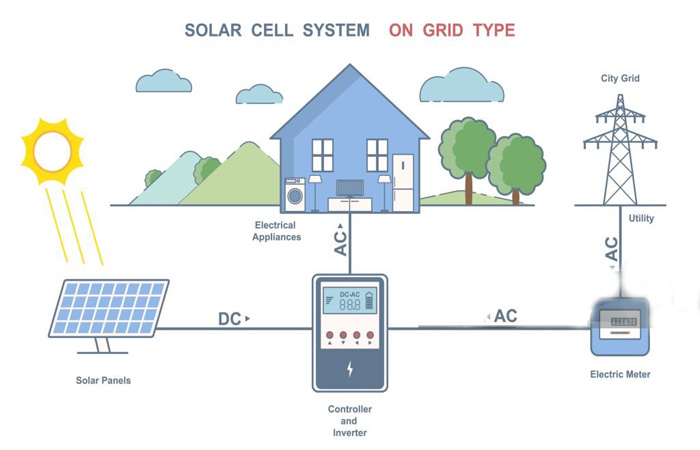1. What is the Islanding Phenomenon in Grid-Tied PV Systems?
Definition
The islanding phenomenon occurs in grid-tied photovoltaic (PV) systems when the grid experiences a power outage, but the PV system continues supplying power to the connected loads. This creates a localized “island” of power generation.
Dangers of Islanding
- Safety Hazards: Risk to utility workers repairing the grid.
- Equipment Damage: Electrical components may malfunction due to unstable voltage and frequency.
- Grid Instability: Uncontrolled islands can disrupt the synchronized operation of the larger grid.
2. Key Features and Parameters of Suitable Inverters
Essential Features of Inverters
- Anti-Islanding Protection: Utilizes active and passive detection methods to immediately shut down during grid failure.
- Efficient MPPT (Maximum Power Point Tracking): Maximizes energy conversion from PV panels.
- High Conversion Efficiency: Typically >95% to minimize energy losses.
- Smart Communication: Supports protocols like RS485, Wi-Fi, or Ethernet for monitoring.
- Remote Management: Allows for monitoring and control of the system remotely.
Key Technical Parameters
| Parameter | Recommended Range |
|---|---|
| Output Power Range | 5kW – 100kW |
| Output Voltage/Frequency | 230V/50Hz or 400V/60Hz |
| Protection Rating | IP65 or higher |
| Total Harmonic Distortion | <3% |
Comparison Table
| Feature | Inverter A | Inverter B | Inverter C |
| Efficiency | 97% | 96% | 95% |
| MPPT Channels | 2 | 3 | 1 |
| Protection Rating | IP66 | IP65 | IP67 |
| Anti-Islanding Response | <2 seconds | <3 seconds | <2 seconds |
3. The Connection Between PV Cable Selection and Islanding Prevention
Importance of PV Cables
High-quality PV cables play a vital role in maintaining system stability and ensuring accurate detection of grid conditions, which is critical for anti-islanding mechanisms.
- Efficient Power Transmission: Reduces voltage drops and energy losses, ensuring consistent power flow to the inverter.
- Signal Accuracy: Minimizes electrical noise and impedance variations, improving the inverter’s ability to detect grid failures.
- Durability: Ensures long-term reliability in various environmental conditions, maintaining steady performance.
4. Recommended PV Cables for Grid-Tied Systems
Top PV Cable Options
- EN H1Z2Z2-K
- Features: Low-smoke, halogen-free, high weather resistance.
- Compliance: Meets IEC 62930 standards.
- Applications: Ground-mounted and rooftop PV systems.
- TUV PV1-F
- Features: Excellent temperature resistance (-40°C to +90°C).
- Compliance: TÜV certification for high safety standards.
- Applications: Distributed PV systems and agrivoltaics.
- Armored PV Cables
- Features: Enhanced mechanical protection and durability.
- Compliance: Meets IEC 62930 and EN 60228 standards.
- Applications: Industrial-scale PV systems and harsh environments.
Parameter Comparison Table
| Cable Model | Temperature Range | Certifications | Applications |
| EN H1Z2Z2-K | -40°C to +90°C | IEC 62930 | Rooftop and utility PV systems |
| TUV PV1-F | -40°C to +90°C | TÜV Certified | Distributed and hybrid systems |
| Armored PV Cable | -40°C to +125°C | IEC 62930, EN 60228 | Industrial PV installations |
Danyang Winpower Wire and Cable Mfg Co., Ltd.
Manufacturer of electrical equipment and supplies, main products include power cables, wiring harnesses and electronic connectors. Applied to smart home systems, photovoltaic systems, energy storage systems, and electric vehicle systems
Conclusion and Recommendations
- Understanding Islanding: Islanding poses significant risks to safety, equipment, and grid stability, necessitating effective prevention measures.
- Choosing the Right Inverter: Select inverters with anti-islanding protection, high efficiency, and robust communication capabilities.
- Prioritizing Quality Cables: Opt for PV cables with high durability, low impedance, and reliable performance to ensure system stability.
- Regular Maintenance: Periodic inspections of the PV system, including inverters and cables, are crucial for long-term reliability.
By carefully selecting the right components and maintaining the system, grid-tied PV installations can achieve optimal performance and safety while adhering to industry standards.
Post time: Dec-24-2024


